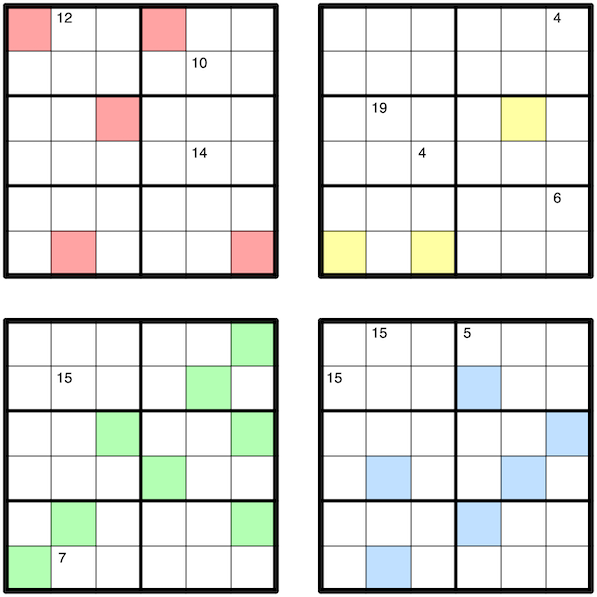Shading Sudoku Collection

Rules:
In each of the four grids, place the numbers from 1 to 6 exactly once in every row, column, and box. Each grid obeys one of the four following binary shading rules, to be determined, and each grid has a unique set of rules. Between adjacent puzzles, cells that share the same grid boundary have the same shading.
Cave:
Shade some cells such that all unshaded cells are orthogonally connected, and all orthogonally connected groups of shaded cells touch the perimeter. A cell with a number in its top left corner indicates the sum of the numbers seen in all four orthogonal directions, including itself, where shaded cells obstruct vision. A colored cell is unshaded and indicates the amount of numbers seen in all four orthogonal directions, including itself, where shaded cells obstruct vision. Numbers may not repeat in the field of vision of either clue type.
Snake:
Shade some cells such that all shaded cells are connected and form a 1-cell wide path that does not branch or touch itself orthogonally. The path may touch itself diagonally. A cell with a number in its top left corner is unshaded and indicates the sum of numbers in that orthogonally connected group of unshaded cells. Numbers may repeat within these groups. A colored cell indicates the number of shaded cells in the 3x3 area centered at that cell.
Yin Yang:
Shade some cells such that all shaded cells are orthogonally connected and all unshaded cells are orthogonally connected. No 2x2 area may be fully shaded or fully unshaded. A cell with a number in its top left corner indicates the sum of numbers in shaded cells in either the row or the column shared with the clue cell. A colored cell indicates the number of shaded cells in the 3x3 area centered at that cell.
Nurikabe (Inverted):
Shade some cells such that all unshaded cells are orthogonally connected and no 2x2 area is entirely unshaded. Shaded cells form islands, and numbers on an island may not repeat. A cell with a number in its top left corner indicates the sum of the numbers on that island. A colored cell is shaded and indicates the number of cells on that island.